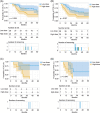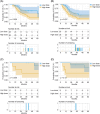Low versus high dose of postoperative radiotherapy for locally advanced esophageal squamous cell carcinoma: a propensity score-matched analysis
- PMID: 40337268
- PMCID: PMC11935151
- DOI: 10.1002/pro6.1192
Low versus high dose of postoperative radiotherapy for locally advanced esophageal squamous cell carcinoma: a propensity score-matched analysis
Abstract
Objective: This study aimed to investigate the effect of different postoperative radiotherapy doses on the prognosis of patients with esophageal squamous cell carcinoma (ESCC).
Methods: A total of 199 patients (aged 18-75 years) with locally advanced ESCC who underwent esophagectomy and postoperative radiotherapy/chemoradiotherapy at the Fujian Cancer Hospital between July 2008 and January 2018 were included. Based on the postoperative radiotherapy dose, the patients were divided into a low-dose group (50-50.4 Gy; median dose 50 Gy) and a high-dose group (>50.4 Gy; median dose 60 Gy). Neoadjuvant and adjuvant chemotherapy regimens included PF (fluorouracil and cisplatin) and TP (paclitaxel and cisplatin) regimens. Patients were followed-up every 3 months in the first 2 years after surgery, every 6 months for the next 3 years, and then subsequently once a year. The primary endpoints were overall survival (OS) and progression-free survival (PFS) rates. The propensity-score matching (PSM) method was applied to identify a 1:1, well-balanced matched cohort with 33 patients in each group for survival comparison.
Results: Among the 199 patients enrolled in this study, 144 and 55 were in the low-dose and high-dose groups, respectively. Univariate and multivariate analyses showed that pathological N classification, vascular tumor emboli, and postoperative radiotherapy dose were independent prognostic factors for both OS and PFS, all p < 0.05. Before PSM, the OS and the PFS of the low-dose group were significantly longer than those of the high-dose group, both p < 0.05. After PSM, better OS and PFS rates were observed in the low-dose group, both p < 0.05. The results showed that patients with pathological stages N0-2 or N3, negative surgical margins, and no vascular tumor emboli could obtain a significant benefit in both OS and PFS after treatment with a low dose of postoperative radiotherapy (50-50.4 Gy). In the subgroup with positive surgical margins, treatment with a low dose of postoperative radiotherapy offered a non-significant survival benefit compared to treatment with a high dose of postoperative radiotherapy.
Conclusions: Our study revealed that for patients with ESCC, the low-dose group (50-50.4 Gy) had a significantly higher OS and PFS than the high-dose group (>50.4 Gy). It was suggested that 50-50.4 Gy might be the recommended postoperative radiotherapy dose for ESCC patients.
Keywords: esophageal squamous cell carcinoma; postoperative radiotherapy; propensity score matching; radiation dose.
© 2023 The Authors. Precision Radiation Oncology published by John Wiley & Sons Australia, Ltd on behalf of Shandong Cancer Hospital & Institute.
Conflict of interest statement
The authors declare no conflicts of interest.
Figures





Similar articles
-
Induction immunotherapy plus chemotherapy followed by definitive chemoradiation therapy in locally advanced esophageal squamous cell carcinoma: a propensity-score matched study.Cancer Immunol Immunother. 2024 Feb 16;73(3):55. doi: 10.1007/s00262-024-03649-x. Cancer Immunol Immunother. 2024. PMID: 38366287 Free PMC article.
-
[Clinical study of postoperative adjuvant radiotherapy and postoperative concurrent chemoradiotherapy for locally advanced hypopharyngeal squamous cell carcinoma].Zhonghua Er Bi Yan Hou Tou Jing Wai Ke Za Zhi. 2019 Sep 7;54(9):662-669. doi: 10.3760/cma.j.issn.1673-0860.2019.09.004. Zhonghua Er Bi Yan Hou Tou Jing Wai Ke Za Zhi. 2019. PMID: 31550757 Chinese.
-
Concurrent chemoradiotherapy versus radiotherapy alone for patients with locally advanced esophageal squamous cell carcinoma in the era of intensity modulated radiotherapy: a propensity score-matched analysis.Thorac Cancer. 2021 Jun;12(12):1831-1840. doi: 10.1111/1759-7714.13971. Epub 2021 May 5. Thorac Cancer. 2021. PMID: 33949784 Free PMC article.
-
Comparison of cisplatinum/paclitaxel with cisplatinum/5-fluorouracil as first-line therapy for nonsurgical locally advanced esophageal squamous cell carcinoma patients.Drug Des Devel Ther. 2016 Jul 1;10:2129-36. doi: 10.2147/DDDT.S105441. eCollection 2016. Drug Des Devel Ther. 2016. PMID: 27445460 Free PMC article.
-
Intensity-modulated radiotherapy with more than 60 Gy improved the survival of inoperable patients with locally advanced esophageal squamous cell carcinoma: A population-based real-world study.Medicine (Baltimore). 2022 Apr 22;101(16):e29166. doi: 10.1097/MD.0000000000029166. Medicine (Baltimore). 2022. PMID: 35482986 Free PMC article.
Cited by
-
Identification and validation of a prognostic signature of m5C-related genes for esophageal cancer.J Thorac Dis. 2025 Jun 30;17(6):4117-4135. doi: 10.21037/jtd-2025-768. Epub 2025 Jun 26. J Thorac Dis. 2025. PMID: 40688336 Free PMC article.
References
-
- Sung H, Ferlay J, Siegel RL, et al. Global cancer statistics 2020: GLOBOCAN estimates of incidence and mortality worldwide for 36 cancers in 185 countries. CA Cancer J Clin. 2021;71(3):209‐249. - PubMed
-
- Kelly RJ. Emerging multimodality approaches to treat localized esophageal cancer. J Natl Compr Canc Netw. 2019;17(8):1009‐1014. - PubMed
LinkOut - more resources
Full Text Sources
Miscellaneous
